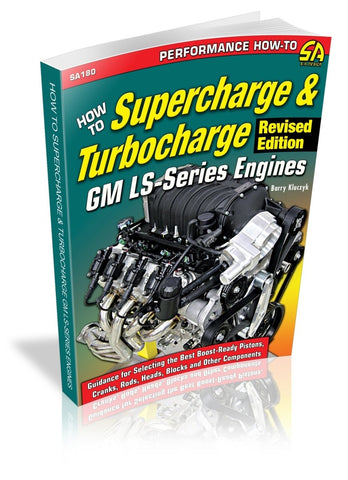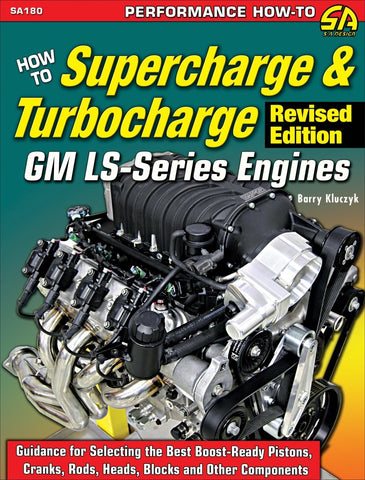Boost the performance of your GM LS-Series engine by learning about supercharger and turbocharger systems, how to select the right parts, installation, tuning, and much more.
This revised edition of How to Supercharge & Turbocharge GM LS-Series Engines is the only book on the market dedicated specifically to forced induction for LS-Series engines, and it will help you gain a solid understanding of how supercharger and turbocharger systems work so you can select the best system for your budget, engine, and application.
The attributes of Roots-type and centrifugal-type superchargers as well as turbochargers are extensively discussed to establish a solid base of knowledge. Benefits and drawbacks of each system are explained as well as the impact of systems on the vehicle.
Also covered in detail are the installation challenges, necessary tools, and the time required to do the job. Once the system has been installed, the book covers tuning, maintenance, and how to avoid detonation so the engine stays healthy. Cathedral, square, and D-shaped port design heads are explained in terms of performance, as well as strength and reliability of the rotating assembly, block, and other components.
Finally, author Barry Kluczyk explains how to adjust the electronic management system to accommodate a supercharger or turbocharger. This book provides exceptional guidance on the wide range of systems and kits available for arguably the most popular modern V-8 on the market today.
If you want to dramatically increase the power of your GM LS-Series engine using forced induction, look no further than the pages of this detailed volume.
Dedication
Acknowledgments
Introduction
Chapter 1: LS Engines and Forced Induction
LS Family Tree
Gen III Versus Gen IV
Supercharging Versus Turbocharging
Understanding Boost (Including PSI Versus Bar)
Drag Racing
LS Performance Potential
Cast Rotating Parts: Pushing the Factory Parts’ Envelope
Compression Ratio and Recommended Boost Limits
Crankcase Ventilation
Importance of Tuning and Avoiding Detonation
Charge Cooling/Intercooling
Auxiliary Instruments
Forced-Induction Terms
Real-World Project: Larry Dye’s 1,300-hp Gen V Camaro SS
Chapter 2: Supercharger Types and Selection
Positive-Displacement Superchargers
Centrifugal Superchargers
Kit and Cost Considerations
Positive-Displacement Versus Centrifugal Blowers
How Much “Blower” Do You Need?
Positive-Displacement Blowers: Calculating Boost and Increased Boost with a Pulley Change
Centrifugal Superchargers: Calculating Maximum Boost
Music to the Ears?
The Importance of a Charge Cooler
Surge Protection
Pulley Size and Performance
Belt Wrap and Belt Size
GM Factory-Supercharged LS9 and LSA Engines
Chapter 3: Turbocharger Types and Selection
LS-Powered Production Vehicles
Turbocharger Component Terms 36 Operation Basics
Understanding Turbocharger Sizes
Selecting the Right-Size Turbocharger
Turbocharger Aspect Ratio
Pitfalls of Mixing Turbines and Compressors
Elements of a Turbo System
Boost Controller and Turbo Timer
Single- Versus Twin-Turbo Systems
Bolt-On Turbo Kits and Tuner Systems
Chapter 4: Kit Preinstallation
Body and Chassis Component Removal
Engine Preparation
Fuel-Pressure Relief
Oil Pan/Oil System Modifications
“Pinning” the Crankshaft
Fuel Pump
Fuel Injectors
Spark Plugs
Real-World Project: Camshaft and Valve Springs Swap
Chapter 5: Supercharger Installation Projects
Project 1: Roots/Screw-Type Supercharger Kit
Project 2: Centrifugal Supercharger Kit
Chapter 6: Turbocharger Installation Projects
Real-World Project: Lingenfelter System
Custom Turbo System Fabrication
The STS Option
Building a Race Car around a Turbo System
Chapter 7: Tuning for Supercharged and Turbocharged Engines
Air + Fuel = Horsepower
Mass Airflow Versus Speed Density
Map Sensors
GM Controllers
Prepackaged Programming
Aftermarket Flash Software
Livernois Motorsports’ X-Treme Cal Tuning System
Stand-Alone Control Systems
Chassis Dyno Tuning
Wideband Tuning
Throttle Body Considerations
Electronic Throttle Concerns
Methanol Injection
E85 Conversion Basics
Chapter 8: Building an LS Engine for Boost: Cylinder Block and Rotating Assembly
Cylinder Block
Resleeving the Factory Aluminum Block
Installing Piston Oil Squirters
Rotating Assembly
Chapter 9: Building an LS Engine: Heads, Cam, and Induction
Cylinder Heads
Valves
Valvetrain Components
Cylinder Head Gaskets
Camshaft
Turbocharger Camshaft
Ignition and the Crank Trigger Conversion
Intake Manifold
Throttle Body
Fuel Injectors
Chapter 10: Engine Build Projects
Supercharged Engine Build
Turbocharged Engine Build
Source Guide
Boost the performance of your GM LS-Series engine by learning about supercharger and turbocharger systems, how to select the right parts, installation, tuning, and much more.
This revised edition of How to Supercharge & Turbocharge GM LS-Series Engines is the only book on the market dedicated specifically to forced induction for LS-Series engines, and it will help you gain a solid understanding of how supercharger and turbocharger systems work so you can select the best system for your budget, engine, and application.
The attributes of Roots-type and centrifugal-type superchargers as well as turbochargers are extensively discussed to establish a solid base of knowledge. Benefits and drawbacks of each system are explained as well as the impact of systems on the vehicle.
Also covered in detail are the installation challenges, necessary tools, and the time required to do the job. Once the system has been installed, the book covers tuning, maintenance, and how to avoid detonation so the engine stays healthy. Cathedral, square, and D-shaped port design heads are explained in terms of performance, as well as strength and reliability of the rotating assembly, block, and other components.
Finally, author Barry Kluczyk explains how to adjust the electronic management system to accommodate a supercharger or turbocharger. This book provides exceptional guidance on the wide range of systems and kits available for arguably the most popular modern V-8 on the market today.
If you want to dramatically increase the power of your GM LS-Series engine using forced induction, look no further than the pages of this detailed volume.
Dedication
Acknowledgments
Introduction
Chapter 1: LS Engines and Forced Induction
LS Family Tree
Gen III Versus Gen IV
Supercharging Versus Turbocharging
Understanding Boost (Including PSI Versus Bar)
Drag Racing
LS Performance Potential
Cast Rotating Parts: Pushing the Factory Parts’ Envelope
Compression Ratio and Recommended Boost Limits
Crankcase Ventilation
Importance of Tuning and Avoiding Detonation
Charge Cooling/Intercooling
Auxiliary Instruments
Forced-Induction Terms
Real-World Project: Larry Dye’s 1,300-hp Gen V Camaro SS
Chapter 2: Supercharger Types and Selection
Positive-Displacement Superchargers
Centrifugal Superchargers
Kit and Cost Considerations
Positive-Displacement Versus Centrifugal Blowers
How Much “Blower” Do You Need?
Positive-Displacement Blowers: Calculating Boost and Increased Boost with a Pulley Change
Centrifugal Superchargers: Calculating Maximum Boost
Music to the Ears?
The Importance of a Charge Cooler
Surge Protection
Pulley Size and Performance
Belt Wrap and Belt Size
GM Factory-Supercharged LS9 and LSA Engines
Chapter 3: Turbocharger Types and Selection
LS-Powered Production Vehicles
Turbocharger Component Terms 36 Operation Basics
Understanding Turbocharger Sizes
Selecting the Right-Size Turbocharger
Turbocharger Aspect Ratio
Pitfalls of Mixing Turbines and Compressors
Elements of a Turbo System
Boost Controller and Turbo Timer
Single- Versus Twin-Turbo Systems
Bolt-On Turbo Kits and Tuner Systems
Chapter 4: Kit Preinstallation
Body and Chassis Component Removal
Engine Preparation
Fuel-Pressure Relief
Oil Pan/Oil System Modifications
“Pinning” the Crankshaft
Fuel Pump
Fuel Injectors
Spark Plugs
Real-World Project: Camshaft and Valve Springs Swap
Chapter 5: Supercharger Installation Projects
Project 1: Roots/Screw-Type Supercharger Kit
Project 2: Centrifugal Supercharger Kit
Chapter 6: Turbocharger Installation Projects
Real-World Project: Lingenfelter System
Custom Turbo System Fabrication
The STS Option
Building a Race Car around a Turbo System
Chapter 7: Tuning for Supercharged and Turbocharged Engines
Air + Fuel = Horsepower
Mass Airflow Versus Speed Density
Map Sensors
GM Controllers
Prepackaged Programming
Aftermarket Flash Software
Livernois Motorsports’ X-Treme Cal Tuning System
Stand-Alone Control Systems
Chassis Dyno Tuning
Wideband Tuning
Throttle Body Considerations
Electronic Throttle Concerns
Methanol Injection
E85 Conversion Basics
Chapter 8: Building an LS Engine for Boost: Cylinder Block and Rotating Assembly
Cylinder Block
Resleeving the Factory Aluminum Block
Installing Piston Oil Squirters
Rotating Assembly
Chapter 9: Building an LS Engine: Heads, Cam, and Induction
Cylinder Heads
Valves
Valvetrain Components
Cylinder Head Gaskets
Camshaft
Turbocharger Camshaft
Ignition and the Crank Trigger Conversion
Intake Manifold
Throttle Body
Fuel Injectors
Chapter 10: Engine Build Projects
Supercharged Engine Build
Turbocharged Engine Build
Source Guide










